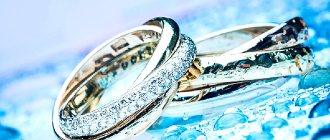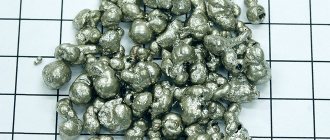What it is?
The most popular question regarding rhodium plated jewelry is what it is. So. Rhodium plated silver is also silver, but coated with a layer of rhodium.
You can often find silver described as “radiated”, but this is completely wrong. This is an important point: radium and rhodium are different metals. Radium, an element produced by the decay of uranium, is radioactive. Although it looks similar to silver in appearance due to its silvery-white color.
Rhodium is a precious metal. In appearance it is very similar to platinum and its value is several times higher than gold. But unlike the precious metals we are used to, rhodium is very fragile, so it is not suitable as the main material for the production of jewelry. At the same time, rhodium has a number of advantages, which allow it to act as a “protective” layer for silver products. Rhodium-plated silver remains shiny and shiny longer, is less susceptible to mechanical damage, does not enter into chemical reactions and cannot be blackened. Actually, this is why jewelers love this expensive precious metal.
Why is it plated with rhodium?
Silver, as you know, although elegant, is a finicky metal. Due to external factors, silver begins to turn black over time, and jewelry no longer looks so aesthetically pleasing. To extend the life of their favorite silver items, jewelers have come up with a trick - covering the silver with a thin layer of rhodium. Due to its properties, rhodium protects the base material from environmental influences and retains the bright color and shine of the base material of the product for a long time.
Rhodium plating is most often applied to silver items, less often to gold items, and never to jewelry in the mass market segment, due to the high cost of the metal itself. The rhodium layer is usually applied no more than 25 microns (can vary from 0.1 to 25 microns). This is such a thin layer that it is absolutely not noticeable on the product. But even this coating is enough to protect a ring or bracelet from scratches and other mechanical damage.
Composition and properties
Rhodium is a fairly rare and hard metal. In 2021, only 21.4 tons of rhodium were mined, and annual production does not exceed 31 tons. This is very little, considering the fact that it is used in many areas and is in many ways superior to platinum in its properties.
Rhodium has higher chemical resistance than platinum, is not subject to corrosion and oxidation, and is resistant to electrical erosion. In addition, an alloy of rhodium and platinum is the most effective catalyst for the production of nitric acid. And at the moment there is not a single alternative to this in the whole world.
But for what properties rhodium is widely used in jewelry:
- Solid and durable
- Not susceptible to oxidation
- Resistant to mechanical damage
- Capable of reflecting up to 80% of visible rays
- Has a beautiful cool shine
- Safe and non-allergenic
This is an ideal material for plating silver. Over time, any silver will tarnish and blacken and will have to be cleaned (we told you how to do this at home here). Plating with rhodium helps to preserve the natural bright silver shine of jewelry longer, while also protecting it from scratches. With rhodium plating, silver rings do not require polishing or cleaning after a short time.
Strength
As already mentioned, rhodium is a durable metal. Rhodium plating gives silver items greater wear resistance and rigidity, helping to retain their original shape. This property of rhodium is especially important for silver rings, which become deformed over time.
Usefulness of rhodium plated silver
In addition to their attractive appearance, rhodium-plated products have medicinal properties: - destroy more than 600 types of pathogenic microorganisms; — prevent infection of scratches; - strengthen the heart; - have a slight cooling effect. Sometimes rhodium plated silver items serve as an indicator of a person's condition. If there is a problem in the body, jewelry changes color. It very rarely happens that rhodium plated silver items are not suitable for a person. A headache, increased nervousness may appear, and the earlobes may become inflamed. In such cases, it is recommended to abandon silver products.
Silver jewelry looks very original and beautiful. They emphasize the individuality and refined taste of their owner.
Receiving technology
Rare rhodium is mined from native platinum, including in Russia (and also in Colombia, Canada and South Africa, where almost 80% of all deposits are located).
Raw platinum is placed in cauldrons, treated with aqua regia and heated for 24 hours. This produces a solution from which, through a few more chemical manipulations, rhodium is obtained - a metal resistant to both acids and alkalis, durable, but very fragile. Therefore, rhodium is not used as the main material for the production of any products. But as a coating that will protect and secure jewelry, rhodium is perfect.
The rhodium plating process is quite simple. The craftsmen use the galvanic method, but before this the product is properly cleaned and degreased. The essence of the method is that an auxiliary object acts as an anode, and the workpiece acts as a cathode. And then, under the influence of electric current, rhodium settles on the surface. The resulting layer is so thin that it is absolutely impossible to recognize.
Advantages and disadvantages
Much has already been said about the advantages of rhodium: strength, wear resistance, resistance to acids and alkalis, and bright shine. But what about the downsides?
But there are shortcomings, like everything. For example, when repairing a product by soldering, the rhodium coating may crack. And in general, with any repair you will have to re-spray. With intensive use, the rhodium coating wears off faster and jewelry with rhodium cannot be cleaned with any abrasives.
This, perhaps, is all the disadvantages. And the advantages of rhodium plating clearly outweigh.
Features of care
Yes, with rhodium plating, silver items are protected from external factors, acids, and scratches. But this means that such jewelry does not need care at all. Here are some rules for care:
- Avoid contact with aggressive cleaning agents, including abrasives, solvents, varnishes and alcohol. This destroys the rhodium plating.
- Store rhodium-plated items separately, in an individual box (but not cardboard) or case.
- Remove rhodium-plated jewelry before exercising, swimming, or cleaning, and don’t forget to take it off at night. Sweat, like chlorinated water, can ruin the spray.
- Wrap earrings, rings, chains that you haven’t worn for a long time in flannel and put them in the closet.
Remember, with proper storage and use, rhodium-plated silver will still turn black over time, but this will be a long process. There is nothing wrong with this - any jewelry maker can clean it and apply a new layer of rhodium for you.
How to clean?
Cleaning rhodium-plated silver at home will not always be effective. Although it is quite difficult to scratch rhodium, it is still possible. Therefore, no abrasive cleaning agents should be used. The best option is a soap solution. It is suitable for cleaning any jewelry - with or without stones, with or without coating.
If you notice even minor damage or cracks on the surface, then without hesitation you need to take the jewelry to a specialist. The technician will carefully remove the damaged old layer and apply a new coating.
In general, jewelers recommend updating the rhodium-plated layer every 3-4 years (less often, it all depends on the intensity of wear).
Silver purification methods
To give a silver product a marketable appearance, the following coatings are used:
- rhodium plating;
- blackening;
- gilding.
Depending on the coating, suitable cleaners are used. There are also products that are not covered with a decorative coating, such as tableware.
Silver cleaners
Rhodium plated silver
Such silver has many advantages, which can confidently include:
- noble appearance;
- protection from mechanical damage;
- protection against oxidation;
- additional rigidity.
Dirt on rhodium-plated silver comes off much easier than on regular silver, since rhodium tends to repel it.

Rhodium plated ring
Such silver also has disadvantages, but they are much fewer.
Namely:
- the cost is higher than that of non-rhodium-plated silver;
- Over time, the coating wears off.
Tips for caring for rhodium-plated silver
Silver with such a coating, despite its higher resistance to oxidation, still does not withstand the effects of sweat. Therefore, it is not recommended to wear such jewelry to fitness classes or to the sauna and bathhouse. It is also worth giving up jewelry on your body while you are applying cosmetics to your skin, including perfume. It's best to wait until they are absorbed.

Remove jewelry before cleaning and going to saunas
Be sure to remove jewelry while cleaning; this rule applies not only to silver items, but to any item in general. Since elementary particles of dirt can get into hard-to-reach places of jewelry, and it will be quite labor-intensive for you to get them out, especially if these are castes for stones.
Cleaning Rhodium Silver
The best solution would be to go to a jewelry store and buy a special cleaning product that is designed specifically for cleaning rhodium-plated silver. The disadvantage of this product is its high cost.
If you decide to clean silver with improvised means, then remember a few rules:
- Never use ammonia (ammonia).
- Avoid using mechanical force on the jewelry, for example, do not rub it with a toothbrush.
- Avoid toothpastes that contain abrasive substances, such as toothpaste.
Taking into account all the above points, you will protect the metal from tarnishing and destruction of the protective layer.
To clean rhodium-plated silver, a simple rinse in warm water and then wiping dry with a piece of soft cloth will be sufficient. It would also be a good idea to use a special polishing cloth.
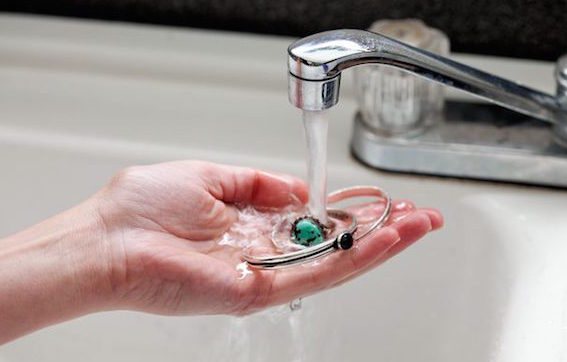
Stones, regardless of whether they are precious or not, should be treated with soapy water using a regular cotton swab. After this, the stones should also be wiped dry with a piece of cloth. But do not wipe the stones with a polishing cloth, as you may scratch them.
Cleaning silver without rhodium plating
With ordinary silver, everything is much simpler, since there are no strict restrictions on the use of any means. Of course, the best option is still to take it to a jewelry shop for cleaning or buy a professional product. But there are also home methods.
The first thing you should do is remove any remaining dirt and grease after wearing your jewelry. To do this, it is enough to hold the products in a soap solution for about 20–30 minutes, and then rinse with it. Afterwards, you need to rinse the jewelry well in running water. Next, simply choose one of the methods to further clean the tarnished silver.
Method 1
The most affordable. You will need a regular toothbrush and toothpaste. Toothpaste can be replaced with a mixture of soda and salt. Simply wet the brush with water and apply the paste or baking soda and salt to the jewelry. Rub the product until the darkening disappears.
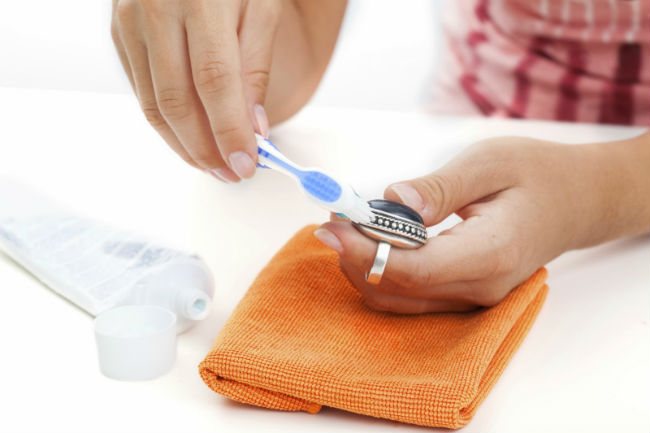
Cleaning the product with toothpaste
Method 2
You will need ash or ash mixed with warm soapy water and ammonia. The manipulations are the same as in the first method, only before doing this you need to soak the product for 10 minutes in this solution.
Method 3
Simply peel a few raw potatoes and place them in a container of water along with your decorations. After a couple of hours, take it out and rinse the products in running water. If the plaque has not completely come off, try cleaning it off with a regular rubber eraser. Also, if you have some water left after boiling the potatoes, you can use that too.
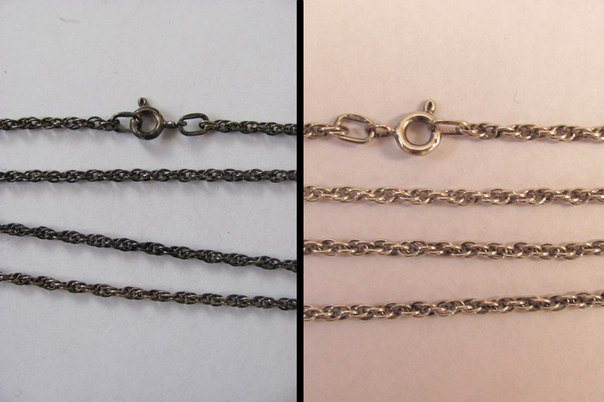
Silver before and after cleaning
You should always wipe rings, earrings, and cutlery immediately after washing. If you often leave them wet, don't be surprised if they turn black over time.
Cleaning blackened silver
Blackened silver is not used in all jewelry; most often it is religious symbols.
Blackening is used to give the effect of depth and emphasize the relief of the product. It is obtained by applying a special oxide, i.e. they artificially create a darkening effect, which, ironically, you are going to get rid of. Therefore, you should be as careful and delicate as possible, since decorative blackening is very easy to remove.

Silver with decorative blackening
In such a situation, your assistant is a soap-soda solution, in which you need to soak your jewelry for about half an hour. After that, simply rinse them with clean water.
Cleaning silver with a matte effect
In this case, you should avoid abrasive materials and any salts and acids. Use regular warm soapy water.
Cleaning silver jewelry with precious stones
- The ones that will cause you the least trouble are:
- sapphire;
- emerald;
- aquamarine.
These are precious stones that have a fairly high density. Therefore, you can use any cleaning method convenient for you.
- With mild detergents, without abrasive particles, it is necessary to clean jewelry that uses inserts from:
- disgrace;
- malachite;
- turquoise;
- moonstone. Ring with opal
- To avoid clouding the color, do not use hot water when cleaning silver with stones:
- ruby;
- topaz;
- pomegranate.
If your jewelry contains inserts made of pearls, coral or ivory, then under no circumstances take independent measures; it is better to take them to a specialist. Otherwise, your jewelry will completely lose its attractive appearance.
Tips for choosing silver jewelry
In conclusion, I would like to share with you a few tips on how to choose silver jewelry and not run into a fake:
- Try. Always look for a sample on the product. Usually the hallmark is placed on the inner surface of the jewelry.
- Certificate of conformity. You will only need it if you choose a product with a gemstone. This will guarantee the authenticity and quality of the stone. Feel free to ask for a certificate from a consultant or seller in an online store.
- Color and shine. If they try to sell you ordinary silver under the guise of rhodium-plated silver, you will know right away. Look at the color of the metal. Natural silver has a slightly grayish tint and is not shiny, but rhodium-plated jewelry will be bright and shiny.
Interesting Facts
There are claims that silver has healing properties and after you have cleaned, for example, your ring of dark plaque, all that remains is to choose the finger on which you will wear it.
- If you suffer from blood pressure, wear a silver ring on your ring fingers.
- Bowel problems? Early wrinkles? Feel free to put the ring on your index finger.
- Heart problems – little finger of the left hand.
- The silver you wear around your neck will help restore and calm the nervous system.[/box]
Try to keep your jewelry in its original condition so that you do not have problems cleaning it. Try not to wear them all the time, take them off when you are at home or when you go to places with high humidity, such as a swimming pool. If, on the contrary, you wear jewelry very rarely, then store it in a dark, dry place, preferably wrapped in foil.
Let your jewelry always remain the way it should be!






